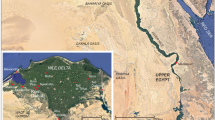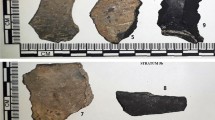Abstract
A detailed archaeometric study of pottery was made of a fifteenth-to-sixteenth-century kiln located inside the walls of the Castle of Alenquer. The locally collected sherds are lead glazed, and mostly exhibit a green or dark yellow decoration. Only in one case, a fragment of a bowl, tin oxide was detected in the white glaze. Pastes from the ceramics of the Alenquer kiln were spectroscopically characterized in terms of their mineralogical and elemental composition. This pottery was fired twice, the first time at high temperatures to produce the biscotto, and the second time at lower temperatures to glaze the ceramics. Although only one type of raw material collected locally was used, two types of ceramic pastes were detected and organized into two groups: one produced at about 850 °C and another at about 950 °C. Pastes from Group 1 were converted into Group 2 pastes whenever the temperature of the kiln was raised from 850 to 950 °C, as confirmed by firing Group 1 pastes in an oven. These results were compared with those obtained for coeval ceramics, namely at Santo António da Charneca and Mata da Machada. Both kilns were located on the south shore of the river Tagus (Lisbon), as previously reported.
Graphical abstract
The first archaeometric study of ceramics produced in the kiln of Alenquer, (Portugal, fifteenth to sixteenth centuries) is reported, with the use of surface spectroscopies techniques, namely micro-Raman. Significant differences were found from two coeval kilns also located at the Tagus basin, Santo António da Charneca and Mata da Machada.

Similar content being viewed by others
References
G. Cardoso, J.J.F. Gomes, S. Rodrigues, L. Batalha, A produção oleira renascentista na bacia hidrográfica do baixo Tejo. Al-Madan IIª Série 2, 54–63 (2016)
L.F. Vieira Ferreira, D.S. Conceição, D.P. Ferreira, L.F. Santos, T.M. Casimiro, I. Ferreira Machado, Portuguese 16th century tiles from Santo António da Charneca’s kiln: a spectroscopic characterization of pigments, glazes and pastes. J. Raman Spectrosc. 45, 838–847 (2014)
T. Casimiro, Faiança portuguesa: datação e evolução crono-estilística. Rev. Port. Arqueol. 16, 351–367 (2013)
C. Torres, Um forno cerâmico dos séculos XV e XVI na cintura industrial de Lisboa, Colloque Fours de Potiers et Testares Médièvaux en Mediterranée occidentale: Métodes et Resultats, Published by Casa de Velazquez, Archaeologie XIII, Madrid 1990, pp. 131–141
L. Barros, L. Batalha, G. Cardoso, A. Gonzalez, A Olaria Renascentista de Santo António da Charneca—Barreiro, in Velhos e Novos Mundos Estudos de Arqueologia Moderna ed. by A. Teixeira, J. Bettencourt (Cham, Lisboa, 2012), pp. 699–710
R. Carmona, C. Santos, Olaria da Mata da Machada: Cerâmica dos Séculos XV e XVI (Câmara Municipal do Barreiro, Barreiro, 2005)
M.L. Sorensen, C. Evans, T.M. Casimiro, Pottery in Cidade Velha—Cabo Verde, in Velhos e Novos Mundos. Estudos de Arqueologia Moderna, ed. by A. Teixeira, J. Bettencourt (Cham, Lisboa, 2012), pp. 813–820
J.M. Teixeira de Carvalho, A Cerâmica Coimbrã no século XVI (Imprensa da Universidade de Coimbra, Coimbra, 1921)
A. Mangucci, Olarias de Louça e Azulejo da Freguesia de Santos-o-Velho: dos meados dos séculos XVI aos meados do século XVII. Al-Madan IIª Série 65, 155–168 (1996)
T.M. Casimiro, Faiança Portuguesa nas ilhas Britânicas (dos finais do Séc XVI aos Inícios do Século XVIII), PhD thesis, Faculdade de Ciências Sociais e Humanas da Universidade Nova de Lisboa, Lisboa, 2010
L.F. Vieira Ferreira, I. Ferreira Machado, A.M. Ferraria, T.M. Casimiro, Ph. Colomban, Portuguese tin-glazed earthenware from the 16th century: a spectroscopic characterization of pigments, glazes and pastes. Appl. Surf. Sci. 285P, 144–152 (2013)
G. Zbyszewski, Carta Geológica dos Arredores de Lisboa na escala 1/50 000 – notícia explicativa da folha 4—Lisboa (Serviços Geológicos de Portugal, Lisboa, 1963)
C. Lepierre, Estudo Chimico e Technologico sobre a Cerâmica Portuguesa Moderna. (Imprensa Nacional, Lisboa, 1899)
G. Zbyszewski, Carta Geológica de Portugal na escala 1/50 000—notícia explicativa da folha 30-D—Alenquer (Serviços Geológicos de Portugal, Lisboa, 1965)
L.F. Vieira Ferreira, T.M. Casimiro, Ph. Colomban, Portuguese tin-glazed earthenware from the 17th century: pigments and glazes characterization. Spectrochim. Acta, Part A 104, 437–444 (2013)
L.F. Vieira Ferreira, D.S. Conceição, D.P. Ferreira, L.F. Santos, M.F.C. Pereira, T.M. Casimiro, I. Ferreira, Machado, Portuguese tin-glazed earthenware from the 17th century. Part 2: a spectroscopic characterization of pigments, glazes and pastes of the three main production centres. Spectrochim. Acta Part A 149, 285–294 (2015)
L.F. Vieira Ferreira, R. Varela Gomes, M.F.C. Pereira, L.F. Santos, I. Ferreira Machado Islamic ceramics in Portugal found at Silves Castle (8th to 13th c.): an archaeometric characterization. J Archaeol. Sci. Rep. 8, 434–443 (2016)
L.F. Vieira Ferreira, A. Gonzalez, M.F.C. Pereira, L.F. Santos, L.F.,T.M. Casimiro, D.P. Ferreira, D.S. Conceição, I. Ferreira Machado, Spectroscopy of 16th century Portuguese tin-glazed earthenware produced in the region of Lisbon. Ceram. Int. 41, 13433–13446 (2015)
L.F. Vieira Ferreira, I. Ferreira Machado, M.F.C. Pereira, T.M. Casimiro, Portuguese blue-on-blue 16th–17th c. pottery. Archaeometry (2018). https://doi.org/10.1111/arcm.12336
L.F. Vieira Ferreira, I.L. Ferreira Machado, Surface photochemistry: organic molecules within nanocavities of Calixarenes. Curr. Drug. Discov. Technol. 4, 229–245 (2007)
M. Ozçatal, M. Yaygingol, A. Issi, A. Kara, S. Turan, F. Ohyar, S. Pfeiffer Tas, I. Nastova, O. Grupce, B. Minceva-Sukarova, Characterization of lead glazed potteries from Smyrna (Izmir/Turkey) using multiple analytical techniques; part II: body, Ceram. Int. 40, 2153–2160 (2014)
I. Garofano, M.D. Robador, J.L. Perez-Rodriguez, J. Castaing, C. Pacheco, A. Durane, Ceramics from the Alcazar Palace in Seville (Spain) dated between the 11th and 15th centuries: compositions, technological features and degradation processes. J. Eur. Ceram. Soc. 35, 4307–4319 (2015)
N.Q. Liem, G. Sagon, V.X. Quang, H.V. Tan, P. Colomban, Raman Study of microstructure, composition and processing of ancient Vietnamese (proto)porcelains and celadons (13–16th centuries). J. Raman Spectrosc. 31, 933–942 (2000)
P. Colomban, G. Sagon, X. Faurel, Differentiation of antique ceramics from the Raman spectra of their coloured glazes and paintings. J. Raman Spectrosc. 32, 351–360 (2001)
G. Simsek, F. Casadio, P. Colomban, L. Bellot-Gurlet, K.T. Faber, G. Zelleke, V. Milande, E. Moinet, On-site identification of early Böttger red stoneware made at Meissen using portable XRF: 1, body analysis. J. Am. Ceram. Soc. 97, 2745–2754 (2014)
P. Ballirano, C. De Vito, L. Medeghini, S. Mignardi, V. Ferrini, P. Matthia, D. Bersani, P.P. Lottici, A combined use of optical microscopy, X-ray powder diffraction and micro-Raman spectroscopy for the characterization of ancient ceramic from Ebla (Syria). Ceram. Int. 40, 409–419 (2014)
L. Sebastian, A produção oleira de faiança em Portugal (Séculos XVI-XVII), PhD thesis, Faculdade de Ciências Sociais e Humanas da Universidade Nova de Lisboa, Lisboa, 2010, pp 335
M.S. Walton, M.S. Tite, Production technology of Roman lead-glazed pottery and its continuance into late antiquity. Archaeometry 52, 733–759 (2010)
J.W.H. Schreurs, R.H. Brill, Iron and related colours in ancient glasses. Archaeometry 26, 199–209 (1984)
D. Moncke, M. Papageorgiou, A. Winterstein-Beckmann, N. Zacharias, Roman glasses coloured by dissolved transition metal ions: redox-reactions, optical spectroscopy and ligand field theory. J. Archaeol. Sci. 46, 23–36 (2014)
L.C. Prinsloo, Ph Colomban, A Raman spectroscopic study of the Mapungubwe oblates: glass trade beads excavated at an Iron age archaeological site in South Africa. J. Raman Spectrosc. 39, 79–90 (2008)
M.M. Morsi, S.I. El-serbiny, K.M. Mohamed, Spectroscopic investigation of amber colour silicate glasses and factors affecting the amber related absorption bands. Spectrochim. Acta Part A 145, 376–383 (2015)
Ph Colomban, V. Milande, L. Le Bilhan, On-site Raman analysis of Iznik pottery glazes and pigments. J. Raman Spectrosc. 35, 527–535 (2004)
B. Kirmizi, Ph Colomban, B. Quetteb, On-site analysis of Chinese Cloisonné enamels from the fifteenth to the nineteenth centuries. J. Raman Spectrosc. 41, 780–790 (2010)
Ph. Colomban, Polymerization degree and Raman identification of ancient glasses used for jewelry, ceramic enamels and mosaics. J. Non Cryst. Solids 322, 180–187 (2003)
Ph Colomban, O. Paulsen, Non-destructive determination of the structure and composition of glazes by Raman spectroscopy. J. Am. Ceram. Soc. 88, 390–395 (2005)
Ph Colomban, A. Tournié, L. Bellot-Gurlet, Raman identification of glassy silicates used in ceramics, glass and jewellery: a tentative differentiation guide. J. Raman Spectrosc. 37, 841–852 (2006)
Ph. Colomban, On site Raman identification and dating of ancient glasses: a review of procedures and tools. J. Cult. Heritage. 9(Suppl.) e55–e60 (2008)
Ph. Colomban, Pottery, glass and enamelled artefacts: how to extract information on their manufactory technology, origin and age?, in Analytical archaeometry: selected topics, ed. by H. Howell, P. Vandenabeele (Royal Society of Chemistry, Cambridge, 2012), pp. 247–270 (Chap. 8)
RRUFF Project Database, http://rruff.info/. Accessed Feb 2018
Acknowledgements
Thanks are due to FCT, Portugal, for the funding of projects UID/NAN/50024/2013, M-ERA-MNT/0002/2015, and Pest-OE/CTM/LA0024/2013. Also to Guilherme Cardoso and Luísa Batalha for supplying part of the samples used in this paper. A final reading of the manuscript is acknowledged to Ilda Januário.
Author information
Authors and Affiliations
Corresponding author
Rights and permissions
About this article
Cite this article
Ferreira, L.F.V., Machado, I.F., Gonzalez, A. et al. A new fifteenth-to-sixteenth-century pottery kiln on the Tagus basin, Portugal. Appl. Phys. A 124, 770 (2018). https://doi.org/10.1007/s00339-018-2197-x
Received:
Accepted:
Published:
DOI: https://doi.org/10.1007/s00339-018-2197-x











